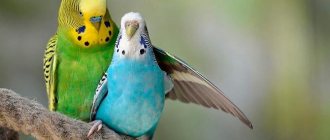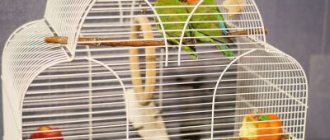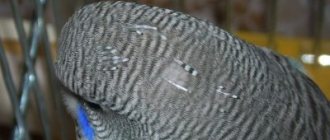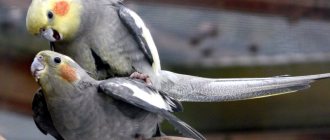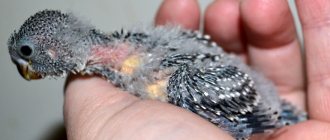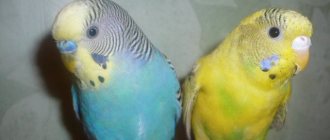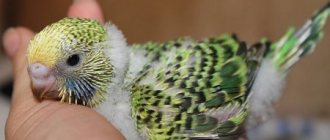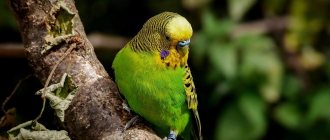Bird nests for budgerigars are created or purchased when there is a desire for further breeding and preservation of offspring. A female parrot is extremely unlikely to lay eggs in an ordinary cage, so the appearance of a nesting house for her offspring is always important.
You can make a nesting house with your own hands from scrap materials, or you can purchase ready-made housing for budgies in special stores; it is important that they are reliable and comfortable.
DIY nesting house for parrots
Not a single purchased nest can compare in comfort to the one that the owner makes for his pets himself.
In the process of making a nesting structure with his own hands, the owner takes into account all the needs of the parrots, while the creation of store-bought houses is simply a production based on speed, and not on caring for the birds. Making breeding housing for parrots with your own hands is not as difficult as it might seem. The main thing is to follow the recommendations and step by step.
Design and dimensions
Before you start working with materials and creating a nest, you should decide on the type of structure and make a drawing of the future structure on paper. For assembly you will need 7 parts:
- 4 walls;
- floor;
- roof;
- perch.
Each of these structural elements (except for the perch - it is not necessary to make a paper stencil for it) must be drawn on paper. Only after double-checking the dimensions of all the details of the structure can the drawn diagram be transferred to the material from which the birdhouse will be built. To do this, all elements are cut out of paper in natural size, and then drawn on the material using these stencils.
Drawing of a nest made of wood.
The table below shows the parameters of the structures.
| Type of nesting structure | Width | Length | Height | Letok (size and location) | perch |
| Horizontal | 25 cm | 20 cm | 15 cm | 4.5 cm in diameter; at a distance of 2-3 cm from the top and one of the side edges of the structure | Does not go inside the structure and protrudes outward by 10 cm |
| Vertical | 20 cm | 20 cm | 25 cm | 4.5 cm in diameter; 3-5 cm below the top edge of the structure | Going inside by 3 cm and sticking out outside by 10 cm |
| Compromise | 25 cm | 20 cm | 20 cm | 5 cm in diameter; at a distance of 3-4 cm from the top and one of the side faces of the structure | Protruding inward by 3 cm and protruding outward by 10 cm |
Tools and materials
When working you will need:
- material of manufacture;
- ruler or tape measure;
- a simple pencil;
- compass;
- saw, jigsaw or hacksaw;
- nails or screws;
- hammer or screwdriver;
- metal fastenings - hooks or brackets (for fixing the house on the bars of the cage).
One of the most important nuances is the choice of material. Experienced parrot breeders do not recommend using the following materials to make a nesting house:
- chipboard;
- plywood;
- plastic;
- cardboard.
Nest placement option. The best houses are those made from natural wood. To cut out structural elements, wooden boards that have not undergone any chemical treatment are used. It is recommended to choose boards from deciduous trees - coniferous wood contains resins that are harmful to the body of birds.
To make the parrots’ nest cozy and warm, boards for various parts should be selected with the following thickness:
- for walls and roof - 2 cm;
- for the bottom - 3-4 cm.
This thickness of the structural elements will allow temperature and humidity levels to remain inside the structure at an optimal level.
Manufacturing process
When the drawing of the parts is made, and the material and tools are prepared, you can begin manufacturing. The whole process takes about 1 hour. Step-by-step procedure:
Cut out 7 structural parts from the selected material (according to the drawing transferred to it) - 4 walls, a roof, a floor and a perch. Draw a circle on the front wall with a compass - this will be the tap hole. Draw another small circle a little lower to secure the perch. Cut both holes. Make 3-4 holes in the side walls for ventilation - each 1 cm in diameter. On the bottom with a slope to the right or left, use a compass to draw a circle with a diameter of 5-8 cm. Cut out this circle and attach it to the same place, but so that the result is a small depression (about 1.5 cm). This will be the laying site - this is where the female will place her eggs. Connect the walls using nails or self-tapping screws. Secure the bottom so that the recess for masonry is removed from the tap hole. Attach the cover. It must be opening - removable or folding. This is necessary both for cleaning and for monitoring the condition of the masonry and newborns. Insert the perch into the prepared hole under the taphole
It is important to make sure that it does not wobble - the thickness of the perch and the diameter of the hole must match. Install fasteners on the top edge of the structure. Scald the finished nest with boiling water for disinfection and dry completely.
You can move on to the next stage - internal arrangement.
House from a pet store: pros and cons
It is much easier to buy a parrot house at a pet store than to bother making one. So it seems. There are advantages to such a purchase: you don’t have to waste time and nerves on building your own home.
The purchased nesting house has much more disadvantages than advantages:
- The material from which it is made. This is chipboard, rarely plywood. There are wooden nests on sale, but their price range is high.
- The house is glued together. What is in the glue is known to the manufacturer. There is no guarantee that it is safe for the health of parrots.
- The thickness of the walls and floor of the house purchased at the pet store is 1 centimeter. Such a nest, especially one made of chipboard, is very cold.
DIY parrot toy
Accessories that are presented in pet stores are not always made of high-quality materials. Knowing how to make a toy for a parrot with your own hands, you can make an interesting item that will be safe for your pet.
Swing
Birds really like colorful swings. You can use materials from scrap materials to make toys for parrots with your own hands. To make the accessory you will need: a perch, beads, wire.
We recommend reading: How to teach your parrot to talk
A triangular base is made from wire. Its length is calculated based on the size of the bird. It should fit freely inside the toy. It is also necessary to leave a few centimeters for fastening. Holes are made in the wooden base with which it will be attached to the base. Bright decorative elements are placed on the wire. The ends of the wire are attached to a wooden element. Then the beads are placed on the base. To place it on the cage, a ring is made at the top of the swing.
Bells
One of the favorite toys of birds is a bell. It can be hung separately in a cage or used as part of an accessory. Let's take a closer look at how to make a bungee toy for a parrot with your own hands. It can be made from the following elements: half a centimeter thick rope, a metal bell, a twig and beads. Knots are made on the rope, alternating them with beads. A perch and a bell are attached to the bottom, and the upper part is tied to the roof of the pet’s home.
Ladders
Birds like to climb stairs. You can make such toys for parrots with your own hands from wooden perches and rope. Sticks of the same length are prepared from tree species that are safe for birds. Branches of bird cherry, oak, pear or poplar are not suitable. Closer to the ends of the poles, small indentations are made for better fixation of the rope. The wooden elements are sanded and then tied together to form a ladder.
Rattles
As a toy for your pet, you can use multi-colored rattles left over from an older child. The teething rattle will be of particular interest because this accessory has an uneven surface. You can decorate it with knots and bright beads.
When thinking about how to make a toy for a parrot with your own hands at home, you should pay attention to the items that are at hand. You can use a plastic container from a Kinder Surprise as a base.
Buttons and beads are placed in it. Small holes are made in the base to prevent small elements from spilling out.
Nesting equipment
It is forbidden to place toys or a mirror in it, so only soft and warm bedding is created. The nest is intended for raising chicks, and not for active play. Therefore, all foreign objects must be kept outside of it. The house does not need special lighting, so it is enough to keep the room light.
The house is equipped with the following elements:
- a special perch that is fixed under the entrance and makes it easier for the female to form a clutch;
- bedding placed on the bottom of the house, and it is made from sawdust mixed with chamomile flowers, and all debris must first be removed.
The presence of a nest in a cage does not guarantee the breeding of parrots, since a trusting relationship must be established between the birds, and they must also be provided with optimal living conditions.
Nest house dimensions
The nesting house for budgerigars is made of wood, rectangular in shape, with a round entrance on the front wall. As a rule, two types of nesting boxes are used – horizontal and vertical. The dimensions of the nest for a budgerigar can be as follows.
Vertical house for budgies
In a vertical house, the bottom is 15-16x15-16 cm, the height is 20-25 cm, the entrance has a diameter of 4.5-5 cm and is located 3 cm below the top edge. The entrance may not be located in the center, but may be shifted slightly to the side
This will protect the eggs from accidental damage by the female if she carelessly descends into the nesting house. A little below the entrance there is a special perch, which extends about 3 cm inside the nesting box for budgerigars
Such a perch helps the female budgerigar carefully descend into and out of the nest.
Horizontal house for budgies
In a horizontal nesting box, the bottom has dimensions of 25x15 cm, the height of the house is 15 cm, and the entrance with a diameter of 5 cm is located on the side at a distance of 3 cm from the top edge and from the side wall. There is a perch on the front outer wall of the entrance, but it does not go inside. For the convenience of the female, a wooden board measuring 15x10x5 cm is placed at the bottom of the nest and secured with a small nail. This board serves as a step for the parrots to climb into and out of the nesting house.
DIY nesting house
Budgerigar lovers often ask the question: “How to make a nest for a budgie yourself?” The answer to this question is simple - you need a little patience and skill. You can make a nest from wooden planks according to the dimensions listed above. In this case, it is necessary to ensure that the edges are neat and well-finished so that no nails stick out anywhere. Otherwise, the parrots may get hurt.
In addition, you need to know that the upper part of the nesting box for budgies is made to open, for which it is attached to two small canopies. This is necessary in order to monitor the condition of the birds in the nest and clean the nesting house.
Wood sawdust should be poured into the bottom of the nesting box, preferably from deciduous trees, since pine sawdust sometimes contains pieces of resin that can stick the egg to the feathers of the female, and she can accidentally take the egg out of the nest and damage it. The layer of sawdust should be approximately 2 cm. Sometimes females are so keen on improving the nest that they throw out all the sawdust from it. In this case, a small recess is made at the bottom of the nesting house for laying - 8 cm in diameter and approximately 1.5 cm deep. If this is not done, the eggs will roll around the nest.
Placement of the nesting house
The nest box is attached to the outside of the cage using two hooks attached to the upper edge of the house.
Parrots are very picky in choosing a nesting house, and do not always easily accept the proposed nesting site. It is better if you offer them two houses at once, attached to opposite walls of the cage.
Both in nature and at home, it is the female who chooses the nest. And once the house(s) are suspended from the cage, she soon begins to explore it. If the nest is suitable, after one, two or at most three weeks the first egg appears in the nest (see How long do budgies hatch eggs?). If even after three weeks the egg does not appear. This means that your birds, for one reason or another, are not inclined to breed offspring.
Cleaning nesting houses
The nesting box and cage must be cleaned every day throughout the nesting period of budgerigars. During harvesting, the chicks are removed from the nest and placed in a box lined with soft cloth. Sticky droppings are removed from the chicks' legs. Heavily dried stains can be washed off with warm water. The nesting house is cleaned of any remaining food, feathers, droppings, and if necessary, washed with warm water and dried well. Cleaning can take a long time, and chicks should not be taken away from their parents for long periods of time. Therefore, it is better to have a second nesting house as a replacement. A new, clean house is attached to the cage and the chicks are placed in it, and the dirty one is washed with warm water and dried until the next replacement. Untimely cleaning and unsanitary conditions in the nesting area lead to diseases of the chicks and their death.
At the age of 4-5 weeks, the chicks leave the nest box, but learn to feed on their own later. Their parents feed them for a long time. Chicks can be separated from their parents at the age of one and a half to two months.
Preparatory work
We start by cutting out all the necessary parts. You should get 4 rectangular blanks with dimensions 25*20 (two walls, bottom and roof) and 2 square blanks 20*20 (side walls). In one of the rectangular blanks we cut out a circle with a diameter of 5 cm. This is the future entrance through which the parrots will penetrate inside. Approximately 2 cm below the tap hole we drill a hole, the diameter of which coincides with the diameter of the perch.
On the front wall (the same one with the entrance) you can attach hooks by which the house will be suspended from the cage. If the cage is large and the nest box is planned to be placed directly inside it, hooks are not needed.
You also need to take care of the bottom, because you need to make a recess in it. It will serve as a nest in which the female will lay eggs so that they do not roll out throughout the house. To make a recess, you need to cut a circle with a diameter of 6 cm into the bottom. Then nail a small piece of board from below to close the hole.
All details are ready. If you plan to fasten them not with nails, but with screws, then additionally drill holes for them.
How to do it yourself?
Before you start building a house with your own hands, you need to create a project and draw sketches, having previously decided on the type of structure and dimensions. The drawings must include all the main details of the house. After this, the building material is prepared, for which boards made from solid wood untreated with chemical compounds are ideal. You can also buy blanks of a certain thickness for assembling the walls; they are sold in every pet store.
Once the type of house has been selected, you can begin to work.
First of all, parts are prepared for assembling the roof, bottom and walls. To do this, sketches are first made on paper, cut out and carefully transferred to boards. Then the parts are cut with a hacksaw. In this case, an additional hole for the taphole should be cut in the front wall, and 3-4 holes with a diameter of no more than 1 cm should be made in the side walls for ventilation.
Before placing parrots in a manufactured birdhouse, all parts of its structure must be disinfected by pouring boiling water over it. After this, the structure is washed again with cold water and dried thoroughly.
In addition, it is important to check all the edges of the house: there should be no nails protruding on them and there should be untreated surfaces
After quality control is completed, the nesting house is fixed inside or outside to one of the walls of the cage. The structure can be secured with either special hooks or brackets. The preparation of the nesting house will be completed with its arrangement, during which it must be remembered that adult budgerigars will live in such a structure only during nesting.
The nesting house can be made from a plywood box, but it should not be painted with varnish or paint. A good place for breeding budgerigars is a nest box. Its design is much simpler compared to nest boxes made of boards.
Since the diameter of such housing should not be less than 22 cm, and the height should not be more than 40 cm, markings are made in the middle of the log and a hole of the appropriate size is made with a chisel. The inside of the hollow should be round and have a wall thickness of 2 cm. In this case, the roof is simply placed on top or secured with a rope. It is advisable to install the resulting house outside the cage, having previously covered it with sawdust. After the cubs hatch and grow up, the nesting house is removed and hidden for storage.
You can learn about the technology for making nesting houses for budgerigars in the following video.
When and where to place a nest
As soon as the owner of the parrots notices that the couple is beginning mating games, you can think about a nesting house.
What are mating games? This is the period when the male is actively courting his girlfriend. She reciprocates his feelings. The birds pluck each other's feathers, chirp for a long time, as if talking, and kiss. Then the nest is placed in the cage. His female will immediately begin to settle down if she is ready to breed.
A breeding house for budgies is set up in two ways. Outside the cage or inside. The first is used in case of small cell sizes. The second option is the most optimal. The nest is attached to the rods. To place the nest inside the cage, it is desirable to have two doors. On one of them they attach the house. A homemade nest for budgies needs proper care.
How to train a parrot to play with toys
Curious pets study with interest new objects that appear in the cage. However, shy individuals ignore even the most unusual and bright accessories. Acquaintance of the parrot with a new object plays an important role. In order for the pet to get used to the accessory, it is necessary to place it in the visibility zone at the level where the bird is usually located. After a few days you can move it closer to the bird.
Attempts to introduce a parrot to a new object should be encouraged. If the parrot approaches or touches an object, it is recommended that the bird be given a treat. The accessory should evoke only positive emotions in the bird. Sometimes a pet doesn't pay attention to a toy because it doesn't know how to use it. The use of the item should be shown to the owner by example. Another way to interest your pet is to first play with the accessory, and then give the bird the opportunity to take it for itself.
We recommend reading: What kind of lamp is needed for a parrot?
It is important to choose the right entertainment objects for your parrot. The pet will be interested in options in which he can chew on elements, rather than more durable items that are practical from the point of view of the bird owner
Balls, rattles, bells are accessories that will help owners have fun spending time with their pet. Using them, the question of how to play with a parrot will no longer arise.
Looking for the ideal place for a nest
It is best to place the box with the cage where there will be no unnecessary fuss. This can be a room or any other room without bright light, lamps and crowds of people and animals. By the way, parrots can look after each other even in a cage with a large number of birds. But when the female is fertilized, she needs privacy. At this time, it is necessary to resettle her from the “neighbors”, ensuring peace and quiet.
From May to September, the cage and box can be kept in the fresh air. When it is cool, it is better to bring the nest indoors. If fertilization occurred during the cold season, then you just need to ventilate the room with the house from time to time.
Nest for budgies: buy or make it yourself?
Before a pair of wavy birds gets ready to breed, you need to make a nest, it is also called a nesting house. This is an important stimulus for the female to lay eggs.
Nesting houses are usually divided into vertical (imagine a kind of narrow mini-birdhouse), horizontal (the principle is the same, only instead of height the house is stretched in width), and a mixed type (the so-called compromise house).
The mixed type combines sufficient width and a high entrance for the female (entry). Thus, in such a nest the disadvantages of the two previous types of nest are solved, and here:
- it is difficult for parrots to fall out or jump out in the first days of life, which means they will be healthier
- the female will not crush the chicks by flying into the house, since the entrance is high above the chicks
- due to its large width, the nesting area is spacious for the female and offspring
How to make a nest
First you need to answer the question: what kind of nest should be for budgies? Of course, comfortable, warm, clean, not cramped and safe.
What you need to pay attention to when buying a nest in a store or building one yourself:
- Materials. Pet stores often offer nesting houses for budgies made of chipboard or plywood. We do not recommend purchasing them, because the materials contain harmful adhesives that have a detrimental effect on the life and health of your pets. Also, manufacturers of houses often sell plastic products. They are harmful when your feathered friend decides to chew on the house. However, pieces of plastic can have a detrimental effect on the health of birds that accidentally ingest them. The best option is a house made of wood, untreated with varnish or paint.
- Dimensions. The size of the nest must be selected depending on where you want to place it (in the cage or behind it), you also need to take into account the dimensions of the cage itself and its location. You can consider several options for a nest for budgies:
- Vertical. The height of the house is greater than its width and length, the entrance is located high and the chicks will not fall out of it prematurely. However, the inconvenience is that the risk of damage to the clutch by the female increases.
- Horizontal. The width of the nest is greater than the height, but the entrance to the house is low, which means the risk of chicks falling out of the nest increases.
- Compromise. They combine the advantages of vertical houses (highly located entrance) and horizontal ones (spacious bottom).
The nesting area should be spacious enough. This is required so that in cramped conditions the female does not accidentally damage the clutch. Also keep in mind that the hatched and slightly grown chicks will also be next to their mother for the first time, so there should be enough space for them too.
- The entrance to the nest, or entrance. This is a round hole (diameter about 5cm), which is located in the upper part of the front side, at a distance of at least 3cm from the socket cover and the side. A perch is installed in the lower part of the entrance; it is used by birds to easily enter the nest. By the way, the perch should be extended into the house - approximately 10 cm in the outer part of the nest and 1.5-2 cm inside the house (for a more accurate descent of the female onto the eggs). A perch inside is not required if the entrance is low. Some owners attach a small board to the inside of the house under the entrance. This is a kind of step on which the female leans before descending onto the eggs.
- Litter. What is the best thing to put in a budgie's nest? The best bedding for parrots is sawdust; they absorb moisture and odors well. The layer of sawdust should be about 3 cm. As an antiseptic measure, you can add a few teaspoons of dried chamomile flowers to the sawdust. Pay attention to the quality of sawdust. They should be small; the female will most likely take large sawdust out of the nest altogether; often larger sawdust is placed along the edge of the house.
- Roof of the house. For easy hygiene measures, the lid should be hinged or removable. This will make it convenient to carry out all activities and look into the nest to check the masonry.
- Ventilation passages. Any living organism needs fresh air, and bird nesting is no exception. For a constant flow of air at the top of the house you need to make several holes.
- Disinfection measures. It is recommended that before installing the bird house, pour boiling water over it, wash it with antiseptic agents and rinse it with boiling water again to remove any remaining disinfectants. Afterwards, dry thoroughly.
Some wavy owners recommend installing the house in the cage itself, and not outside it. They explain this by saying that the female feels calm and confident when the male is nearby. With his support, she does not strive to leave the house faster.
Choosing the optimal type of nesting site
So, let's look at 3 types of nesting houses for parrots. A vertical housing is characterized by a high location of the entrance, which increases the likelihood of damage to eggs by birds. But the chicks cannot fall out of it.
In a horizontal house, the eggs will be reliably protected, in addition, the grown chicks will look out of it and watch with interest what is happening in the room. Parrots will really like the combined nest box, because it combines the advantages of the previous options. Such a dwelling is spacious enough and convenient for raising a large number of chicks.
Anyone can make a house for budgies with their own hands.
Simple vertical house
It is best to make a vertical house for budgies with your own hands from hardwood boards, the thickness of which is no more than 20 mm. First you need to carefully cut out the front, back and side walls of the box. All parts must be the same length and width! The standard dimensions of a home for a pair of budgies are 15 x 15 x 25 cm. Now you can connect the walls of the future home with nails. The bottom of a smooth board should fit them perfectly. To prevent the female from scattering eggs and small chicks along the bottom of the nesting house, it is recommended to make a slight depression in it.
The diameter of the tap hole (inlet) in the front wall of the box is 50 mm. It can be cut using a drill. It is also worth making cutouts. After all, fresh air is very important for the full development of eggs and chicks. It is advisable to attach a piece of plywood inside the nest box as a lip to protect the eggs. Otherwise, the parrot risks damaging them.
It is necessary to drill a hole under the finished taphole to fix a short perch. This is done to make it convenient for birds to enter the home. After all the structural parts are connected to each other, the box must be covered with a lid. A simple and convenient nesting box for parrots is ready! You can secure it to the cage using wire or hooks.
Combined nesting house
A nest box of a combined type is suitable for large budgies. Such a dwelling is quite spacious, so the female does not risk damaging the clutch, and the growing chicks will not be able to leave it prematurely. To make it you will need the same materials as for the vertical house. The height of the combined nesting box is at least 20 cm, and the internal size of the bottom is 22 x 15 cm. The entrance with a perch is located 2.5 cm from the ceiling and front wall. Inside the nest box you need to make a step 3 cm high so that the parrots can comfortably enter it. Do not forget that you need to make a round depression at the bottom for eggs and chicks.
It is recommended to equip such a nesting box with a hinged lid. This way, it will be possible to carry out a daily inspection of the box and remove dirt in a timely manner. The removable cover can be installed using hinges and screws.
Horizontal nest box
How to make a horizontal type nest for budgerigars? It is no secret that this type of nest box is very convenient for the female and her offspring. Kids will be able to look out of it and watch the adult birds with interest. In fact, a horizontal dwelling is designed in the same way as a vertical one.
In the process of making such a nest, you will need the same wooden boards, plywood and nails. From a wooden board you need to carefully cut 2 rectangles measuring 25 x 15 cm, which will serve as the front wall and bottom of the home. Then cut out the side walls in the same way. The recommended size is 15 x 14 cm. Use a sheet of plywood to make a back wall (23 x 15 cm) and a lid (25 x 15 cm) for the house. Using nails, fasten the front wall and the bottom of the future nesting box, then attach the side walls to the edges.
When the base of the dwelling is ready, you can begin drilling the taphole. Its diameter is 50 mm. Just below the entrance, use a drill to make a hole for the perch. How to make a removable nesting cover without using metal hinges? Drill several holes along the upper edge of the back wall at equal distances from each other. The same holes should be drilled along the edge of the box roof. The main thing is that the holes coincide with each other. Now, using rope, secure the roof to the base of the nest box.
The bottom of the box can be divided into 2 parts by attaching a wooden strip in the center. Thanks to this, small chicks will not be able to crawl close to the entrance hole.
What is needed to build a house
First, let's prepare all the necessary materials and tools:
- a piece of untreated board (1 * 0.5 m);
- perch (a round, even stick approximately at least 20 cm long);
- fasteners (small nails, screws, corners);
- hooks for attaching the future house to the cage;
- hammer, drill, jigsaw.
There should be no protruding branches or points on the board. Smooth out any rough edges first so as not to injure yourself and your parrots. It is advisable to carry out all work in the workshop, because wood shavings and dust will fly around the room. You can entrust the responsible task of making a house for your budgies to a handy man (father, grandfather, uncle, neighbor, friend).
Recommendations for breeding budgies
First of all, you should choose a suitable cage for a pair of budgies. Spacious cage with parameters 60x30x40cm. will allow you to move freely in it. As the number of birds increases, the cage must increase accordingly.
A pair of parrots can live in a cage together for quite a long time without mating, and you cannot force them. A female will not mate with a male she does not like. In nature, females always have a choice, and if you don’t please her with a male, you may not be able to wait for a replenishment. But if the male tries to court the female, share food with her, and she does not reject him, then everything will be fine.
It is worth breeding young birds at the age of one and a half years. Such individuals have enough health and strength for offspring.
In terms of mating time, mid-autumn is ideal. In autumn, there is a suitable temperature regime and diet for reproduction and incubation. After all, in the autumn, vitamin and protein supplements begin.
What should the nest be like?
The average nest dimensions are 20x20x20cm. Materials for nesting houses need exclusively natural materials. Any wood is suitable, untreated, without resins or plywood. It cannot be made from chipboard, it is hazardous to health. Store-bought nests are made of plastic and are very cold for the chicks. Some craftsmen make houses for budgies with their own hands from cardboard. It is cold in such nests, it is impossible to wash it, and it is fragile.
Put inside:
- twigs,
- hay,
- sawdust.
Types of nesting houses for parrots and their sizes:
- vertical - 20x20x25cm. It is elongated and fits well into the cage, but the flying female will touch the clutch.
- horizontal - 25x20x15cm. It is the most comfortable for the female. But due to the low altitude, the chicks may leave the nest early.
- compromise - 25x20x20cm. They are comfortable and safe for the female and chicks. The only drawback is the large size.
No matter what type of budgie nest you choose, it should have a hinged lid for cleaning the nest.
Varieties
All breeding nests for budgerigars can be classified according to the structure and shape of the nesting structure. They come in horizontal, vertical and compromise types. Regardless of the external form, they represent a building that is placed inside the cell; sometimes it is attached externally.
You can make a nest for parrots with your own hands from spruce, birch or pine wood, cardboard, and plywood.
Horizontal
Horizontal nesting structures have a significant advantage over others - they are wide and spacious. The design of the house allows the female to easily move around the perimeter without harming the chicks. However, this type of structure has a significant drawback: the exit hole is located low, which is why there is a possibility that the parrot chicks will get out prematurely and may injure themselves. The length of the horizontal house is 20 cm, width 25 cm, height 15. If desired, additional elements and attachments can be attached to the walls.
Vertical
The height of such a house is 25 cm, length 20 cm, width 20. The entrance is located quite high. This advantage of the structure allows the offspring not to leave the territory at an early age, protecting them from negative consequences.
Complex
The complex option is a combined or, as they also say, combined construction. The shape of the house is considered the most convenient, as it contains the positive characteristics of horizontal and vertical models, but without their disadvantages. That is why they are singled out as a universal and most profitable option for purchase or self-production. The size of such structures allows the female budgerigar to move freely, and the offspring also do not have the opportunity to escape prematurely. The combined nesting houses are 20 cm high, 25 cm wide, 20 cm long. They are very easy to assemble.
Parrots are not interested in the nest
Now the bird nesting house is ready. You can offer it to parrots. If they liked him, and the couple has already formed, then there is little time left to wait for offspring. But what should you do if your budgie won't go into the nest box?
The problem is that wavy birds are flocking birds. And this often happens if there is only one pair of birds in the house. Try getting another pair, it might work, but arrange the cages so that each pair can see the other pair. If even after these events the couple is not going to start nesting, then apparently their time has not come yet, remove the nesting house so that the female does not get used to it.
For what other reasons may parrots not be interested in the house at all:
- Please note that the house meets the requirements that we described above.
- Observe how conveniently the nest is located. Perhaps the female is not satisfied with his location. Move the house lower or higher and at the same time monitor the behavior of the bird.
- Where is the nesting cage located? If this is a passing place for people, then the female may be scared and feel insecure and uncomfortable; she needs a feeling of complete security.
- The owner or other residents of the house, guests can often look at the parrots, talk to them, and simply observe. You can't do this at this time. Birds need peace and privacy from humans to reproduce.
To stimulate parrots to procreate, it is necessary to provide them with a balanced and proper diet; it directly affects the production of reproductive hormones.
In addition to the grain mixture, give the birds more protein (boiled eggs), all kinds of fresh vegetables, fruits, herbs, a mineral mixture, crushed shells so that there is enough calcium.
If you have an opposite-sex pair of parrots living at home, and you are going to get offspring from them, sooner or later you will have to start building a house. Only in a nest for budgerigars can the mystery of the birth of chicks take place. How to understand that the time has come for reproduction, and which house to choose - you will find out by reading the article.


